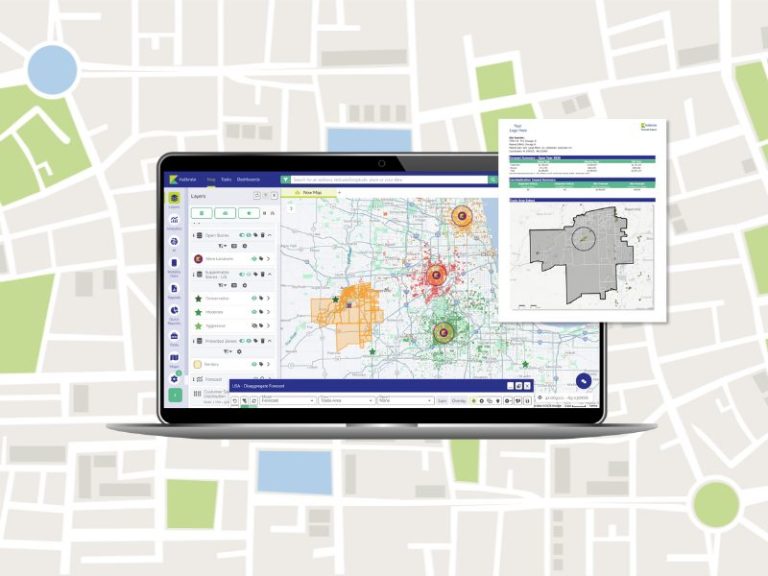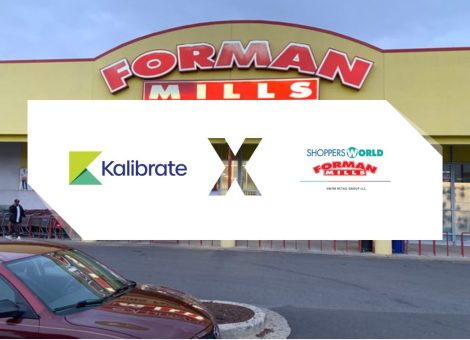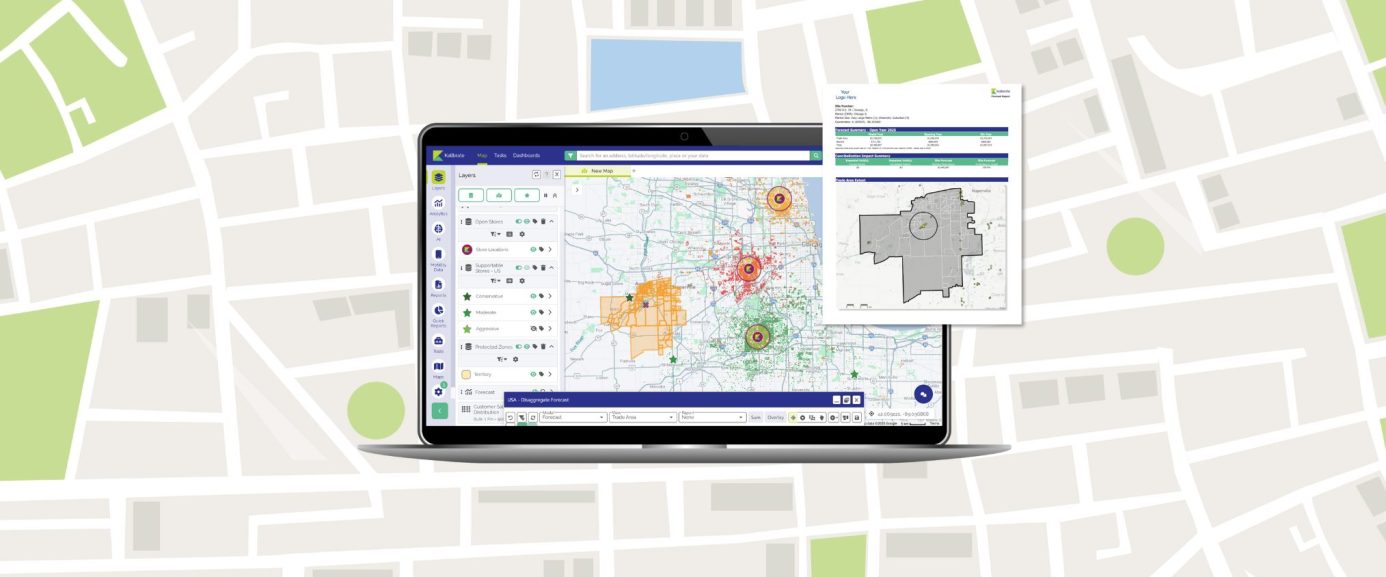Using location intelligence for retail demand forecasting

The success of any retail store depends on how well it taps into the demand around it. But how do we figure out which areas – and which exact spots – hold the greatest potential?
That’s where demand forecasting comes in. By estimating future sales, retailers can see when, where, and how customers are most likely to shop at a new location. This understanding helps decision-makers shape real estate strategies, uncover growth opportunities, and strengthen revenue.
Location intelligence makes this possible.
By studying customer profiles, shopping habits, competitor activity, and broader market trends, retailers can pinpoint the strongest opportunities with greater accuracy. The outcome is a sharper picture of sales potential – revenue forecasts that guide smarter decisions about expansion, marketing, and operations.
What is demand forecasting?
Demand forecasting is the practice of predicting future customer demand for products or services at a given location.
Demand forecasting in the retail industry often means estimating how much business a new store can generate before it even opens its doors. Forecasts are built using historical sales data, customer demographics, seasonal patterns, and other factors that influence buying behavior.
Accurate forecasting gives retailers a forward-looking view of sales potential, helping them decide not only where to open but also how to stock, staff, and promote each store.
Done well, it reduces risk, improves planning, and ensures resources are invested where they’ll have the greatest return.
What is location intelligence?
Location intelligence is the use of geographic and spatial data to better understand markets and customer behavior. For retailers, it’s about connecting the dots between where people live, work, and shop — and how those patterns shape demand for a new store.
This can involve analyzing customer profiles, foot traffic, competitive presence, and neighborhood dynamics across different regions. By layering these insights, retailers can see which areas are underserved, which markets are oversaturated, and where the best opportunities lie.
In short, location intelligence turns raw geographic data into actionable insights that guide expansion, marketing, and operational decisions.
The evolving need for demand forecasting in the retail industry
The retail industry is more dynamic than ever. Shifts in consumer preferences, the continued growth of omnichannel shopping, and increased competition have made intuition-based, ‘gut feel’ retail forecasting methods less effective. Retailers no longer rely solely on past trends in demand to plan their future strategies.
Demand forecasting in the retail industry has evolved into highly-sophisticated, data-driven discipline.
Today’s forecasting models analyze large sets of first party and third-party data — from a deep understanding of customers and competitors’ customers, to shifts in population or new building and development — to provide a more accurate picture of future demand.
This approach helps businesses stay agile, identify opportunities early, and remain competitive in changing markets.
How retail demand forecasting works with location intelligence
When combined, demand forecasting and location intelligence give retailers a sharper edge in selecting, planning, and managing their stores or business locations.
Instead of relying on guesswork, decision-makers gain a forward-looking view of sales potential and a deeper understanding of the markets they want to enter. Key advantages include:
- Smarter site selection – Evaluate potential locations with greater accuracy by combining demand forecasts with insights into neighborhood demographics, traffic flow, and competitor presence. This minimizes the risk of choosing the wrong spot.
- Lower financial risk – By projecting sales before signing a lease, retailers can avoid costly mistakes and direct capital toward opportunities that are more likely to deliver strong returns.
- Improved store performance – Forecasts aren’t just useful during planning; they also guide daily operations. Retailers can better align inventory, staffing, and promotions with local demand, reducing both shortages and waste.
- Faster, more confident growth – With clearer visibility into underserved areas and emerging markets, retailers can expand strategically, gaining first-mover advantages while steering clear of oversaturated regions.
- Data-driven decisions across teams – From real estate and marketing to supply chain, accurate forecasts and location insights help align strategies. Decisions are no longer based solely on intuition but backed by data, making cross-functional planning more effective.
How retail demand forecasting drives new opportunities
At its core, retail demand forecasting is about understanding potential future sales: how a location will perform once open and what the “ramp up” period to maturity will look like. The key outputs of a robust forecast model cover demand, growth, and optimization.
Forecasting helps businesses recognize shifts in market dynamics ahead of the competition, allowing them to adjust strategies proactively.
- Identify growth markets – Skilled location analysts take a macro view of opportunities, evaluating which regions are expanding and how well those markets align with the concept’s target customer profile.
- Optimize promotional and pricing strategies – On an operational level, forecasting reveals how demand shifts under different pricing structures and how targeted marketing campaigns can unlock additional sales from specific customer segments.
- Anticipate seasonality and external factors – Forecasting accounts for fluctuations tied to holidays, weather, or local events, helping businesses prepare for both surges and slowdowns in demand.
- Support long-term planning – By looking beyond immediate sales potential, forecasts guide decisions on staffing, supply chain investments, and real estate timing, ensuring resources are deployed where they will be most effective.
How demand forecasting and location intelligence limit risk
With construction and labor costs at recent highs, the risk associated with failed locations has also become elevated.
Demand forecasting plays a vital role in mitigating risk. Locations that fail to reach a viable level of profitability upon maturity not only harm the bottom line but also damage the reputation of the brand.
But demand forecasting helps more than just accurate site selection. Understanding the granularity of revenue lines helps limit risk in location design too. Consider a quick-serve restaurant with a drive-thru.
Understanding potential demand across dine-in and drive-thru channels is critical when optimizing the size of the restaurant relative to the drive-thru lanes. Any incorrect assumptions in the development phase of the location become costly missteps if the location requires reconfiguration down the line.
Ready to see forecasting in action?
Successful growth doesn’t come from guesswork – it comes from clarity. By combining demand forecasting with location intelligence you can identify the best opportunities, reduce risk, and align every decision with market potential.
Smarter growth starts with smarter insights. Explore our forecasting models to see how data-driven predictions can shape your next location.
Dive deeper into strategies and success stories on the Kalibrate blog, or get in touch to discuss how we can help you make your next move with confidence.
Read more articles about:
Location intelligenceSubscribe and get the latest updates
You may unsubscribe from our mailing list at any time. To understand how and why we process your data, please see our Privacy & Cookies Policy
Related posts
Location intelligence
Forman Mills accelerates growth with the Kalibrate Location Intelligence platform
The value apparel and home goods retailer selects Kalibrate to to support its national expansion strategy.

Location intelligence
The Kalibrate news round-up: November 2025
In this monthly feature, we look across the industry and mainstream news to uncover stories of note that we think are...


